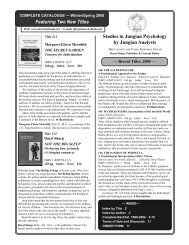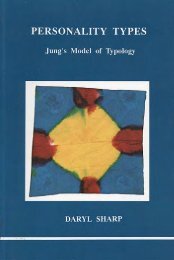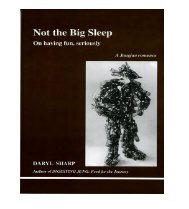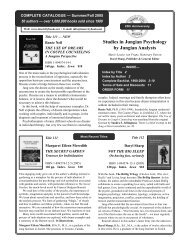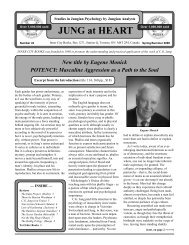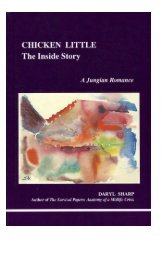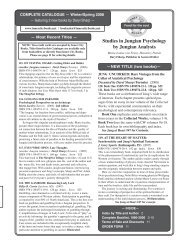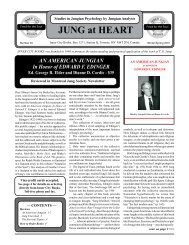Digesting Jung: Food for the Journey - Inner City Books
Digesting Jung: Food for the Journey - Inner City Books
Digesting Jung: Food for the Journey - Inner City Books
You also want an ePaper? Increase the reach of your titles
YUMPU automatically turns print PDFs into web optimized ePapers that Google loves.
14 Archetype, Instinct and Complex<br />
Archetypes are not knowable in <strong>the</strong>mselves, but <strong>the</strong>ir myriad<br />
manifestations—as images, patterns and motifs—are well documented<br />
in art, literature, history and mythology. Odysseus, Joan of<br />
Arc and Pinocchio are archetypal images of <strong>the</strong> hero archetype; <strong>the</strong><br />
goddess Demeter is an archetypal image of <strong>the</strong> mo<strong>the</strong>r archetype;<br />
<strong>the</strong> gods Saturn and Zeus are archetypal images of <strong>the</strong> fa<strong>the</strong>r; Satan<br />
is a personified image of <strong>the</strong> archetype of evil; political parties on<br />
right and left act out <strong>the</strong> “two bro<strong>the</strong>rs” motif (as in <strong>the</strong> enmity of<br />
Cain and Abel), and so on. Needless to say, <strong>the</strong> names given to archetypal<br />
patterns differ according to <strong>the</strong> prevailing culture.<br />
<strong>Jung</strong> used <strong>the</strong> simile of <strong>the</strong> spectrum to illustrate <strong>the</strong> difference<br />
between instinct and <strong>the</strong> archetype as an “instinctual image”:<br />
The dynamism of instinct is lodged as it were in <strong>the</strong> infra-red part of<br />
<strong>the</strong> spectrum, whereas <strong>the</strong> instinctual image lies in <strong>the</strong> ultra-violet<br />
part. . . . The realization and assimilation of instinct never take place<br />
at <strong>the</strong> red end, i.e., by absorption into <strong>the</strong> instinctual sphere, but only<br />
through integration of <strong>the</strong> image which signifies and at <strong>the</strong> same<br />
time evokes <strong>the</strong> instinct. 9<br />
Here is how he pictured <strong>the</strong> relationship between instinct and<br />
archetype, and <strong>the</strong> ways in which each may manifest:<br />
INSTINCTS ARCHETYPES<br />
infrared ________________________________________ ultraviolet<br />
(Physiological: body (Psychological: spirit,<br />
symptoms, instinctual dreams, conceptions,<br />
perceptions, etc.) images, fantasies, etc.)<br />
So, an archetype is a primordial, structural element of <strong>the</strong> human<br />
psyche—a universal tendency to <strong>for</strong>m certain ideas and images and<br />
to behave in certain ways. Instincts are <strong>the</strong> physiological counterparts<br />
of archetypes. Complexes, arising from our individual experience<br />
in <strong>the</strong> here and now, put skin and flesh on <strong>the</strong> collective bones<br />
of instinct, archetype and archetypal image.<br />
9 Ibid., par. 414.



